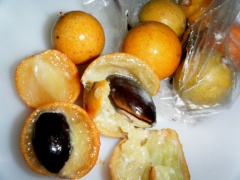Difference between revisions of "Balata"
| Line 7: | Line 7: | ||
| risk factors = See text | | risk factors = See text | ||
}} | }} | ||
| + | __TOC__ | ||
==Description== | ==Description== | ||
Balata is a nonelastic rubber obtained chiefly from the tree Manilkara bidentata of Venezuela, Brazil, and the Guianas. It is similar to [[Gutta Percha]] and is used as a substitute. The material contains a high percentage of [[gums]] and is more tacky than rubber, but it can be vulcanized. It differs from rubber in being a transisomer of iso-prene with a dissimilar polymerization. Balata has been used principally for transmission and conveyor belts and for golf ball covers. For conveyer belts, heavy duck is impregnated with balata solution and vulcanized. The belts have high tensile strength, good flexibility, and wear resistance. The wood of the balata tree is used for cabinetwork and for rollers and bearings. It is called bulletwood in the Guianas, but this name is also applied to the wood of the gutta-percha trees of Asia. The wood is extremely hard and durable and has a density of 66 lb/ft3 (1,057 kg/m<sup>3</sup>). It has a deep-red color and a fine, open [[grain]]. | Balata is a nonelastic rubber obtained chiefly from the tree Manilkara bidentata of Venezuela, Brazil, and the Guianas. It is similar to [[Gutta Percha]] and is used as a substitute. The material contains a high percentage of [[gums]] and is more tacky than rubber, but it can be vulcanized. It differs from rubber in being a transisomer of iso-prene with a dissimilar polymerization. Balata has been used principally for transmission and conveyor belts and for golf ball covers. For conveyer belts, heavy duck is impregnated with balata solution and vulcanized. The belts have high tensile strength, good flexibility, and wear resistance. The wood of the balata tree is used for cabinetwork and for rollers and bearings. It is called bulletwood in the Guianas, but this name is also applied to the wood of the gutta-percha trees of Asia. The wood is extremely hard and durable and has a density of 66 lb/ft3 (1,057 kg/m<sup>3</sup>). It has a deep-red color and a fine, open [[grain]]. | ||
Latest revision as of 10:32, 29 October 2012
| Infobox on Balata | |
|---|---|
| Example of Balata |  |
| Facts | |
| Origin | South America and Asia |
| Stowage factor (in m3/t) | - |
| Humidity / moisture | - |
| Ventilation | - |
| Risk factors | See text |
Balata
Contents
Description
Balata is a nonelastic rubber obtained chiefly from the tree Manilkara bidentata of Venezuela, Brazil, and the Guianas. It is similar to Gutta Percha and is used as a substitute. The material contains a high percentage of gums and is more tacky than rubber, but it can be vulcanized. It differs from rubber in being a transisomer of iso-prene with a dissimilar polymerization. Balata has been used principally for transmission and conveyor belts and for golf ball covers. For conveyer belts, heavy duck is impregnated with balata solution and vulcanized. The belts have high tensile strength, good flexibility, and wear resistance. The wood of the balata tree is used for cabinetwork and for rollers and bearings. It is called bulletwood in the Guianas, but this name is also applied to the wood of the gutta-percha trees of Asia. The wood is extremely hard and durable and has a density of 66 lb/ft3 (1,057 kg/m3). It has a deep-red color and a fine, open grain.
Application
Used as an insulating material, for water proofing and in the manufacture of golf ball covers.











